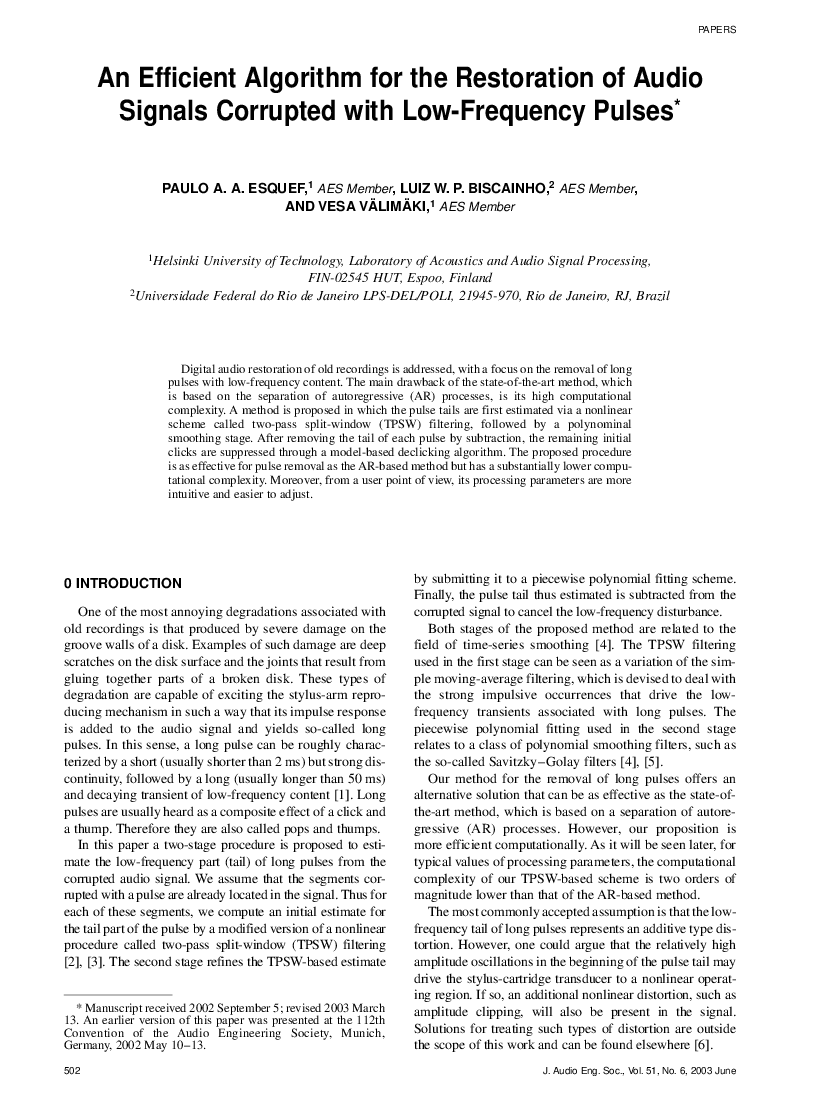Home / Publications / E-library page
You are currently logged in as an
Institutional Subscriber.
If you would like to logout,
please click on the button below.
Home / Publications / E-library page
Only AES members and Institutional Journal Subscribers can download
Digital audio restoration of old recordings is addressed, with a focus on the removal of long pulses with low-frequency content. The main drawback of the state-of-the-art method, which is based on the separation of autoregressive (AR) processes, is its high computational complexity. A method is proposed in which the pulse tails are first estimated via a nonlinear scheme called two-pass split-window (TPSW) filtering, followed by a polynominal smoothing stage. After removing the tail of each pulse by subtraction, the remaining initial clicks are suppressed through a model-based declicking algorithm. The proposed procedure is as effective for pulse removal as the AR-based method but has a substantially lower computational complexity. Moreover, from a user point of view, its processing parameters are more intuitive and easier to adjust.
Author (s): Esquef, Paulo A. A.; Biscainho, Luiz W. P.; Välimäki, Vesa
Affiliation:
Helsinki University of Technology, Laboratory of Acoustics and Audio Signal Processing, HUT, Espoo, Finland ; Universidade Federal do Rio de Janeiro LPS-DEL/POLI, Rio de Janeiro, RJ, Brazil
(See document for exact affiliation information.)
Publication Date:
2003-06-06
Import into BibTeX
Permalink: https://aes2.org/publications/elibrary-page/?id=12221
(756KB)
Click to purchase paper as a non-member or login as an AES member. If your company or school subscribes to the E-Library then switch to the institutional version. If you are not an AES member Join the AES. If you need to check your member status, login to the Member Portal.

Esquef, Paulo A. A.; Biscainho, Luiz W. P.; Välimäki, Vesa; 2003; An Efficient Algorithm for the Restoration of Audio Signals Corrupted with Low-Frequency Pulses [PDF]; Helsinki University of Technology, Laboratory of Acoustics and Audio Signal Processing, HUT, Espoo, Finland ; Universidade Federal do Rio de Janeiro LPS-DEL/POLI, Rio de Janeiro, RJ, Brazil; Paper ; Available from: https://aes2.org/publications/elibrary-page/?id=12221
Esquef, Paulo A. A.; Biscainho, Luiz W. P.; Välimäki, Vesa; An Efficient Algorithm for the Restoration of Audio Signals Corrupted with Low-Frequency Pulses [PDF]; Helsinki University of Technology, Laboratory of Acoustics and Audio Signal Processing, HUT, Espoo, Finland ; Universidade Federal do Rio de Janeiro LPS-DEL/POLI, Rio de Janeiro, RJ, Brazil; Paper ; 2003 Available: https://aes2.org/publications/elibrary-page/?id=12221
@article{esquef2003an,
author={esquef paulo a. a. and biscainho luiz w. p. and välimäki vesa},
journal={journal of the audio engineering society},
title={an efficient algorithm for the restoration of audio signals corrupted with low-frequency pulses},
year={2003},
volume={51},
issue={6},
pages={502-517},
month={june},}